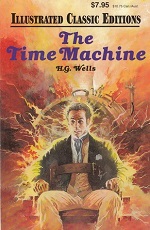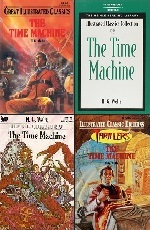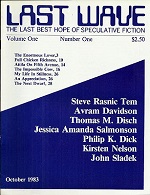|  | | | |  1983 Baronet/Playmore edition 1983 Baronet/Playmore edition

 four later editions four later editions

| | Illustrated Classics Edition:
The Time Machine
aka Great Illustrated Classics: The Time Machine
adapted by Shirley Bogart (story) and Brendan Lynch (art)
First publication: 1983

 If you are a misguided completist, you may find yourself drawn to reading the new Chapter 13 in Bogart’s adaptation in which the traveller finds himself in an authoritarian 22nd century populated by 1950s cape-wearing, B-movie characters. Do so if you must, but try to resist the urge to read any of the rest of Bogart’s adaptation for pre-teens, and whatever else you do, don’t let the book fall into the hands of your eight-to-twelve-year-old. If you are a misguided completist, you may find yourself drawn to reading the new Chapter 13 in Bogart’s adaptation in which the traveller finds himself in an authoritarian 22nd century populated by 1950s cape-wearing, B-movie characters. Do so if you must, but try to resist the urge to read any of the rest of Bogart’s adaptation for pre-teens, and whatever else you do, don’t let the book fall into the hands of your eight-to-twelve-year-old.

The first edition was released in 1983, possibly in multiple formats, although I’ve never spotted what I believe was the first edition published by Waldman Publishing in 1983; multiple editions, including a Chinese translation, have appeared since. A figure in a silver cape and tights, with gloves to match, was saying, “That’s enough Apathy-Gas, Kolar. There’s only one passenger.’ A figure in a silver cape and tights, with gloves to match, was saying, “That’s enough Apathy-Gas, Kolar. There’s only one passenger.’ 

—from the new Chapter 13: The Golden Age of Science
| |
| | | | |

 
 
 
 
 
 
 
 
 
 
 
 
 | | | |  | | “Full Chicken Richness”
by Avram Davidson
First publication: Last Wave, Oct 1983

 Every now and then, I’ll be reading a story, not really sure whether it’s meant to be sf or not, but realizing that it has a pleasant sfnal tone—and then, voila!, there’s time travel. Davidson’s story is a piece that lives on the edge between real and surreal, ostensibly telling the story of Fred Hopkins, an artist who puts old buildings on canvas and takes a late morning breakfast at La Bunne Burger. Every now and then, I’ll be reading a story, not really sure whether it’s meant to be sf or not, but realizing that it has a pleasant sfnal tone—and then, voila!, there’s time travel. Davidson’s story is a piece that lives on the edge between real and surreal, ostensibly telling the story of Fred Hopkins, an artist who puts old buildings on canvas and takes a late morning breakfast at La Bunne Burger. He read on: Ingredients: Water, Other Poultry and Poultry Parts, Dehydrated Vegetables, Chickens and Chicken Parts, seasoning . . . the list dribbled off into the usual list of chemicals. He read on: Ingredients: Water, Other Poultry and Poultry Parts, Dehydrated Vegetables, Chickens and Chicken Parts, seasoning . . . the list dribbled off into the usual list of chemicals. 
| |
| | | | |

 
 
 
 
No Time Travel. Move along. |
“Beyond the Dead Reef” by James Tiptree, Jr., F&SF, Jan 1983 [no definite time travel ]

“Concerto in B Demolished” by Al Sirois, Asimov’s Science Fiction, Jan 1983 [clones ]

“After-Images” by Malcolm Edwards, Interzone, Spring 1983 [differing time rates ]

The Crucible of Time by John Brunner, Sep 1983 [despite title, no time travel ]
aka The Fire Is Lit, aka “Fusing and Refusing” (excerpts)

| |     |